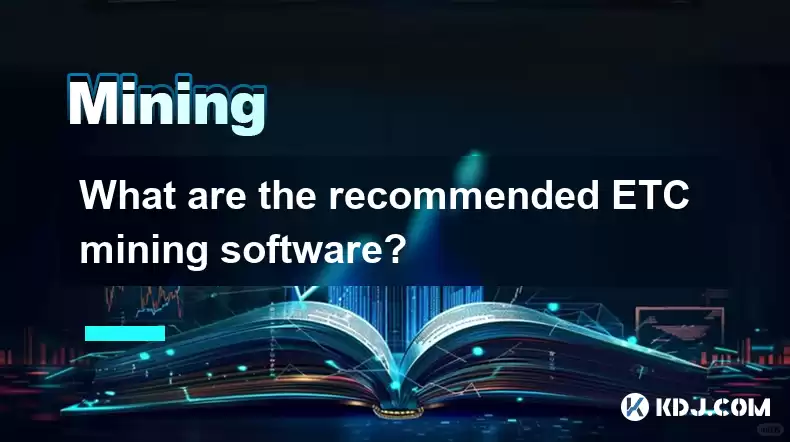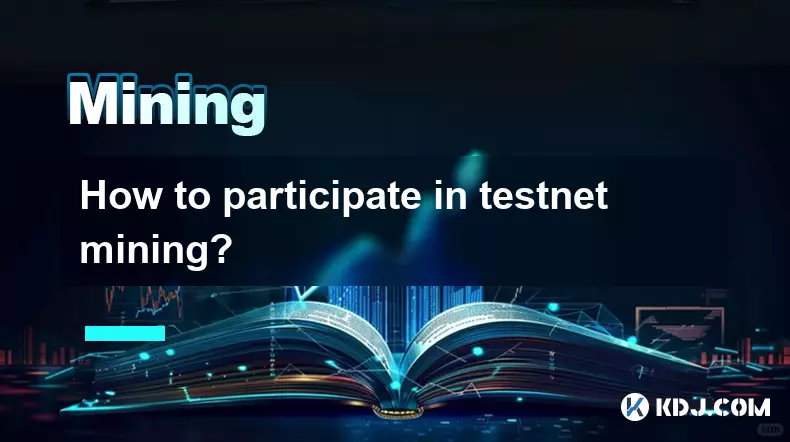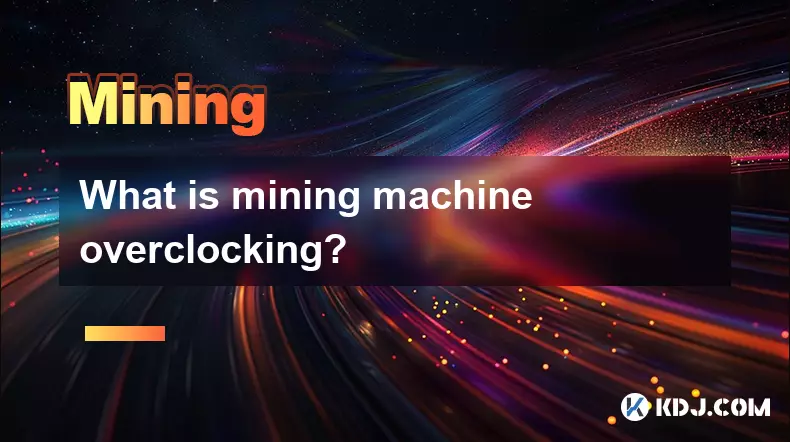-
 bitcoin
bitcoin $109523.663807 USD
-0.13% -
 ethereum
ethereum $4019.526508 USD
2.06% -
 tether
tether $1.000482 USD
0.00% -
 xrp
xrp $2.776815 USD
0.18% -
 bnb
bnb $958.942396 USD
0.12% -
 solana
solana $204.294698 USD
3.84% -
 usd-coin
usd-coin $0.999693 USD
0.00% -
 dogecoin
dogecoin $0.232115 USD
2.09% -
 tron
tron $0.338028 USD
0.84% -
 cardano
cardano $0.790920 USD
1.50% -
 hyperliquid
hyperliquid $44.871443 USD
5.60% -
 ethena-usde
ethena-usde $1.000322 USD
0.04% -
 chainlink
chainlink $21.034165 USD
2.60% -
 avalanche
avalanche $28.794831 USD
-0.54% -
 stellar
stellar $0.360466 USD
1.24%
What are the recommended ETC mining software?
Choosing ETC mining software depends on your hardware (CPU or GPU) and expertise; popular GPU options include Claymore's (use caution, updates ceased), PhoenixMiner, and TeamRedMiner, while CPU miners like CPUMiner-multi and ccminer exist, though less profitable. Prioritize hashrate, power consumption, compatibility, ease of use, and security when selecting software.
Mar 14, 2025 at 04:20 pm

- This article explores various ETC mining software options, focusing on their features, ease of use, and profitability.
- We'll examine both CPU and GPU mining software, considering their respective strengths and weaknesses.
- The article will discuss factors to consider when choosing mining software, such as profitability, hardware compatibility, and security.
- We will also touch upon the importance of staying updated with the latest software versions and security patches.
Choosing the right ETC mining software is crucial for maximizing your profitability and ensuring a smooth mining experience. The best software for you will depend on your hardware (CPU or GPU) and your technical expertise. There's no single "best" option, as individual needs vary.
GPU Mining Software for ETC:Several software options cater specifically to GPU mining, leveraging the parallel processing power of graphics cards for efficient ETC mining. These programs often offer features like overclocking controls, monitoring tools, and remote management capabilities.
- Claymore's Dual Ethereum+ETC Miner: This popular miner is known for its high hashing power and relatively low power consumption. It supports various AMD and Nvidia GPUs. However, it’s important to note that Claymore’s development has ceased, meaning security updates are no longer provided. Use caution and ensure you download from a reputable source.
- PhoenixMiner: Another well-regarded GPU miner, PhoenixMiner offers competitive hashing rates and is often praised for its stability and ease of use. It boasts support for a wide range of GPUs and offers various configuration options. Regular updates are important to maintain performance and security.
- TeamRedMiner: This miner focuses on AMD GPUs and is known for its high performance and efficient power usage on AMD cards. It's a strong contender for AMD users seeking optimal hashrate and efficiency.
While less efficient than GPU mining, CPU mining can still be a viable option for those without access to powerful graphics cards. The profitability is significantly lower, however.
- CPUMiner-multi: This open-source miner supports multiple algorithms, including those used for ETC mining. It’s a versatile option for those experimenting with different cryptocurrencies or with limited hardware resources. Its performance will be significantly lower than GPU mining.
- ccminer: Another open-source option, ccminer provides support for various cryptocurrencies, including ETC, and can be used for CPU mining. Like CPUMiner-multi, its efficiency is significantly lower than GPU mining. This makes it less profitable, but can be useful for learning purposes.
Several factors should influence your software selection. Prioritize these elements for a successful and profitable mining experience.
- Hashrate: The hashrate directly impacts your mining profitability. Choose software known for high hashrates on your specific hardware. Compare benchmarks before committing to a particular software.
- Power Consumption: Mining consumes electricity. Select software known for efficient power usage to minimize operational costs and maximize profitability.
- Hardware Compatibility: Ensure the software supports your specific graphics cards or CPU. Check the software's documentation for compatibility information.
- Ease of Use: Some miners have simpler interfaces than others. Choose one that aligns with your technical skills and comfort level. Complex configurations may require more technical expertise.
- Security: Download software only from trusted sources. Avoid modified or cracked versions, as these may contain malware or compromise your system security. Regular updates are essential.
The cryptocurrency landscape is constantly evolving. Regularly check for updates to your chosen mining software. Updates often include performance improvements, bug fixes, and crucial security patches. Outdated software can be vulnerable to exploits and may impact your mining efficiency.
Common Questions:Q: Is ETC mining profitable? A: ETC mining profitability depends heavily on several factors, including the price of ETC, the difficulty of the network, your hardware's hashrate, and electricity costs. It's crucial to perform a profitability calculation before investing in mining hardware and software.
Q: What hardware do I need for ETC mining? A: For optimal profitability, you'll need a powerful GPU. CPU mining is possible but significantly less efficient. Consider your electricity costs when assessing hardware requirements.
Q: Are there risks associated with ETC mining? A: Yes. Risks include hardware failure, fluctuating cryptocurrency prices, and the potential for software vulnerabilities. Proper research and risk mitigation strategies are essential.
Q: How do I monitor my ETC mining progress? A: Most mining software includes built-in monitoring tools to track your hashrate, earnings, and other relevant metrics. Some offer remote monitoring capabilities.
Q: Is it legal to mine ETC? A: The legality of cryptocurrency mining depends on your jurisdiction. Research your local laws and regulations before engaging in ETC mining.
Disclaimer:info@kdj.com
The information provided is not trading advice. kdj.com does not assume any responsibility for any investments made based on the information provided in this article. Cryptocurrencies are highly volatile and it is highly recommended that you invest with caution after thorough research!
If you believe that the content used on this website infringes your copyright, please contact us immediately (info@kdj.com) and we will delete it promptly.
- Rare 1p Coin Could Fetch £200,000: Are You Holding a Fortune?
- 2025-09-27 12:25:13
- MAGACOIN Finance: Buzz, Risks, and the Altcoin Stampede
- 2025-09-27 12:25:13
- Crypto Wallets & Utility Tokens: What's the Hype?
- 2025-09-27 12:30:02
- Shiba Inu's Burn Rate & Crypto Payroll: A New York Perspective
- 2025-09-27 12:45:11
- Grayscale, Near Protocol, and On-Chain Innovation: A New Era for Crypto?
- 2025-09-27 12:45:11
- Punjab Govt, Centre, and the Financial Package: A Tug-of-War?
- 2025-09-27 12:30:02
Related knowledge

The difference between staking and mining
Sep 24,2025 at 05:18am
Understanding Staking in the Cryptocurrency Ecosystem1. Staking involves holding funds in a cryptocurrency wallet to support the operations of a block...

How to participate in testnet mining?
Sep 22,2025 at 09:18am
Understanding Testnet Mining in the Crypto Ecosystem1. Testnet mining is a method used by blockchain developers to simulate real-world conditions on a...

How to dispose of abandoned mining machines?
Sep 19,2025 at 08:19pm
Assessing the Condition of Abandoned Mining Rigs1. Begin by inspecting each mining machine for visible damage, corrosion, or missing components. Machi...

How to identify high-quality mining pools?
Sep 21,2025 at 03:19pm
Reputation and Track Record1. A mining pool’s reputation is built over time through consistent performance and transparency. Pools that have operated ...

Advantages of decentralized mining pools
Sep 20,2025 at 04:36pm
Enhanced Security and Resistance to Censorship1. Decentralized mining pools operate on blockchain-based smart contracts, eliminating the need for a ce...

What is mining machine overclocking?
Sep 21,2025 at 07:19pm
Understanding Mining Machine Overclocking1. Mining machine overclocking refers to the process of increasing the operating frequency of a cryptocurrenc...

The difference between staking and mining
Sep 24,2025 at 05:18am
Understanding Staking in the Cryptocurrency Ecosystem1. Staking involves holding funds in a cryptocurrency wallet to support the operations of a block...

How to participate in testnet mining?
Sep 22,2025 at 09:18am
Understanding Testnet Mining in the Crypto Ecosystem1. Testnet mining is a method used by blockchain developers to simulate real-world conditions on a...

How to dispose of abandoned mining machines?
Sep 19,2025 at 08:19pm
Assessing the Condition of Abandoned Mining Rigs1. Begin by inspecting each mining machine for visible damage, corrosion, or missing components. Machi...

How to identify high-quality mining pools?
Sep 21,2025 at 03:19pm
Reputation and Track Record1. A mining pool’s reputation is built over time through consistent performance and transparency. Pools that have operated ...

Advantages of decentralized mining pools
Sep 20,2025 at 04:36pm
Enhanced Security and Resistance to Censorship1. Decentralized mining pools operate on blockchain-based smart contracts, eliminating the need for a ce...

What is mining machine overclocking?
Sep 21,2025 at 07:19pm
Understanding Mining Machine Overclocking1. Mining machine overclocking refers to the process of increasing the operating frequency of a cryptocurrenc...
See all articles










































































